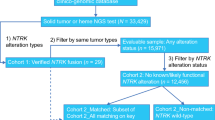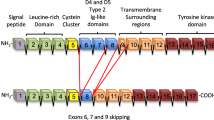Abstract
Purpose
High messenger RNA (mRNA) expression of the tropomyosin receptor kinase C gene (TrkC) has been associated with favorable survival in medulloblastoma patients. Untested is whether it plays a role through modulating the response to therapy or whether it might be a surrogate marker for a favorable molecular subgroup.
Methods
The medulloblastoma-derived cell line DAOY was stably transfected to overexpress TrkC (clone DAOY-TrkC) and compared to a control (clone DAOY-EV, empty vector transfected). Cell viability (MTS assay) was tested after irradiation or incubation with chemotherapeutic drugs. Neuroradiologic response to postoperative chemotherapy or craniospinal irradiation (CSI) of medulloblastoma patients aged 3–21 years with postoperative residual disease treated within the consecutive trials HIT’91/HIT2000 was compared to TrkC mRNA expression in their tumor samples. Five well-characterized independent expression-profiling studies covering together 686 medulloblastoma patients were analyzed for TrkC levels according to the molecular subgroups.
Results
Cell viability of DAOY-TrkC compared to DAOY-EV was not different after exposure to increasing doses of irradiation, cisplatin, etoposide, or vincristine. While TrkC mRNA expression tended to be higher in non-responders (n = 5/19) to postoperative CSI (p = 0.03, ratio 15.5, 95% CI 9–267), this was the case in responders (n = 23/43) to chemotherapy (p = 0.04, ratio 6.1, 95% CI 1.1–35), both analyzed with Mann–Whitney U test (not significant after Bonferroni adjustment). The highest TrkC mRNA levels were found in the SHH subgroup across all expression-profiling studies.
Conclusions
High TrkC mRNA expression appears to be frequent in the SHH subgroup and seems not to have a major effect on therapy responsiveness in medulloblastoma patients.




Similar content being viewed by others
References
Bassili M, Birman E, Schor NF, Saragovi HU (2010) Differential roles of Trk and p75 neurotrophin receptors in tumorigenesis and chemoresistance ex vivo and in vivo. Cancer Chemother Pharmacol 65:1047–1056. doi:10.1007/s00280-009-1110-x
Buhren J, Christoph AH, Buslei R, Albrecht S, Wiestler OD, Pietsch T (2000) Expression of the neurotrophin receptor p75NTR in medulloblastomas is correlated with distinct histological and clinical features: evidence for a medulloblastoma subtype derived from the external granule cell layer. J Neuropathol Exp Neurol 59:229–240
Chang CH, Housepian EM, Herbert C Jr (1969) An operative staging system and a megavoltage radiotherapeutic technic for cerebellar medulloblastomas. Radiology 93:1351–1359. doi:10.1148/93.6.1351
Eberhart CG, Kaufman WE, Tihan T, Burger PC (2001) Apoptosis, neuronal maturation, and neurotrophin expression within medulloblastoma nodules. J Neuropathol Exp Neurol 60:462–469
Eberhart CG, Kratz J, Wang Y, Summers K, Stearns D, Cohen K, Dang CV, Burger PC (2004) Histopathological and molecular prognostic markers in medulloblastoma: c-myc, N-myc, TrkC, and anaplasia. J Neuropathol Exp Neurol 63:441–449
Eggert A, Brodeur GM, Ikegaki N (2000) Relative quantitative RT-PCR protocol for TrkB expression in neuroblastoma using GAPD as an internal control. Biotechniques 28:681–682 686, 688-691
Gajjar A, Hernan R, Kocak M, Fuller C, Lee Y, McKinnon PJ, Wallace D, Lau C, Chintagumpala M, Ashley DM, Kellie SJ, Kun L, Gilbertson RJ (2004) Clinical, histopathologic, and molecular markers of prognosis: toward a new disease risk stratification system for medulloblastoma. J Clin Oncol 22:984–993. doi:10.1200/JCO.2004.06.032
Grotzer MA, Eggert A, Zuzak TJ, Janss AJ, Marwaha S, Wiewrodt BR, Ikegaki N, Brodeur GM, Phillips PC (2000) Resistance to TRAIL-induced apoptosis in primitive neuroectodermal brain tumor cells correlates with a loss of caspase-8 expression. Oncogene 19:4604–4610. doi:10.1038/sj.onc.1203816
Grotzer MA, Janss AJ, Fung K, Biegel JA, Sutton LN, Rorke LB, Zhao H, Cnaan A, Phillips PC, Lee VM, Trojanowski JQ (2000) TrkC expression predicts good clinical outcome in primitive neuroectodermal brain tumors. J Clin Oncol 18:1027–1035
Gruber-Olipitz M, Strobel T, Chen WQ, Grotzer MA, Quehenberger F, Slavc I, Lubec G (2008) Synthesis, chaperoning, and metabolism of proteins are regulated by NT-3/TrkC signaling in the medulloblastoma cell line DAOY. J Proteome Res 7:1932–1944. doi:10.1021/pr700724a
Haberler C, Slavc I, Czech T, Gelpi E, Heinzl H, Budka H, Urban C, Scarpatetti M, Ebetsberger-Dachs G, Schindler C, Jones N, Klein-Franke A, Maier H, Jauk B, Kiefer A, Hainfellner JA (2006) Histopathological prognostic factors in medulloblastoma: high expression of survivin is related to unfavourable outcome. Eur J Cancer 42:2996–3003. doi:10.1016/j.ejca.2006.05.038
Kaatsch P, Rickert CH, Kuhl J, Schuz J, Michaelis J (2001) Population-based epidemiologic data on brain tumors in German children. Cancer 92:3155–3164
Kim JY, Sutton ME, Lu DJ, Cho TA, Goumnerova LC, Goritchenko L, Kaufman JR, Lam KK, Billet AL, Tarbell NJ, Wu J, Allen JC, Stiles CD, Segal RA, Pomeroy SL (1999) Activation of neurotrophin-3 receptor TrkC induces apoptosis in medulloblastomas. Cancer Res 59:711–719
Kool M, Koster J, Bunt J, Hasselt NE, Lakeman A, van Sluis P, Troost D, Meeteren NS, Caron HN, Cloos J, Mrsic A, Ylstra B, Grajkowska W, Hartmann W, Pietsch T, Ellison D, Clifford SC, Versteeg R (2008) Integrated genomics identifies five medulloblastoma subtypes with distinct genetic profiles, pathway signatures and clinicopathological features. PLoS One 3:e3088
Korshunov A, Savostikova M, Ozerov S (2002) Immunohistochemical markers for prognosis of average-risk pediatric medulloblastomas. The effect of apoptotic index, TrkC, and c-myc expression. J Neuro-Oncol 58:271–279
Lannering B, Rutkowski S, Doz F, Pizer B, Gustafsson G, Navajas A, Massimino M, Reddingius R, Benesch M, Carrie C, Taylor R, Gandola L, Bjork-Eriksson T, Giralt J, Oldenburger F, Pietsch T, Figarella-Branger D, Robson K, Forni M, Clifford SC, Warmuth-Metz M, von Hoff K, Faldum A, Mosseri V, Kortmann R (2012) Hyperfractionated versus conventional radiotherapy followed by chemotherapy in standard-risk medulloblastoma: results from the randomized multicenter HIT-SIOP PNET 4 trial. J Clin Oncol 30:3187–3193. doi:10.1200/JCO.2011.39.8719
Nakagawara A (2001) Trk receptor tyrosine kinases: a bridge between cancer and neural development. Cancer Lett 169:107–114
Northcott PA, Korshunov A, Witt H, Hielscher T, Eberhart CG, Mack S, Bouffet E, Clifford SC, Hawkins CE, French P, Rutka JT, Pfister S, Taylor MD (2011) Medulloblastoma comprises four distinct molecular variants. J Clin Oncol 29:1408–1414. doi:10.1200/JCO.2009.27.4324
Pomeroy SL, Sutton ME, Goumnerova LC, Segal RA (1997) Neurotrophins in cerebellar granule cell development and medulloblastoma. J Neuro-Oncol 35:347–352
Pomeroy SL, Tamayo P, Gaasenbeek M, Sturla LM, Angelo M, McLaughlin ME, Kim JY, Goumnerova LC, Black PM, Lau C, Allen JC, Zagzag D, Olson JM, Curran T, Wetmore C, Biegel JA, Poggio T, Mukherjee S, Rifkin R, Califano A, Stolovitzky G, Louis DN, Mesirov JP, Lander ES, Golub TR (2002) Prediction of central nervous system embryonal tumour outcome based on gene expression. Nature 415:436–442. doi:10.1038/415436a
Ray A, Ho M, Ma J, Parkes RK, Mainprize TG, Ueda S, McLaughlin J, Bouffet E, Rutka JT, Hawkins CE (2004) A clinicobiological model predicting survival in medulloblastoma. Clin Cancer Res 10:7613–7620. doi:10.1158/1078-0432.CCR-04-0499
Remke M, Hielscher T, Korshunov A, Northcott PA, Bender S, Kool M, Westermann F, Benner A, Cin H, Ryzhova M, Sturm D, Witt H, Haag D, Toedt G, Wittmann A, Schottler A, von Bueren AO, von Deimling A, Rutkowski S, Scheurlen W, Kulozik AE, Taylor MD, Lichter P, Pfister SM (2011) FSTL5 is a marker of poor prognosis in non-WNT/non-SHH medulloblastoma. J Clin Oncol 29:3852–3861. doi:10.1200/JCO.2011.36.2798
Rutkowski S, von Bueren A, von Hoff K, Hartmann W, Shalaby T, Deinlein F, Warmuth-Metz M, Soerensen N, Emser A, Bode U, Mittler U, Urban C, Benesch M, Kortmann RD, Schlegel PG, Kuehl J, Pietsch T, Grotzer M (2007) Prognostic relevance of clinical and biological risk factors in childhood medulloblastoma: results of patients treated in the prospective multicenter trial HIT'91. Clin Cancer Res 13:2651–2657. doi:10.1158/1078-0432.CCR-06-1779
Schuller U, Heine VM, Mao J, Kho AT, Dillon AK, Han YG, Huillard E, Sun T, Ligon AH, Qian Y, Ma Q, Alvarez-Buylla A, McMahon AP, Rowitch DH, Ligon KL (2008) Acquisition of granule neuron precursor identity is a critical determinant of progenitor cell competence to form Shh-induced medulloblastoma. Cancer Cell 14:123–134. doi:10.1016/j.ccr.2008.07.005
Schuller U, Koch A, Hartmann W, Garre ML, Goodyer CG, Cama A, Sorensen N, Wiestler OD, Pietsch T (2005) Subtype-specific expression and genetic alterations of the chemokinereceptor gene CXCR4 in medulloblastomas. Int J Cancer 117:82–89. doi:10.1002/ijc.21116
Segal RA (2003) Selectivity in neurotrophin signaling: theme and variations. Annu Rev Neurosci 26:299–330. doi:10.1146/annurev.neuro.26.041002.131421
Segal RA, Goumnerova LC, Kwon YK, Stiles CD, Pomeroy SL (1994) Expression of the neurotrophin receptor TrkC is linked to a favorable outcome in medulloblastoma. Proc Natl Acad Sci U S A 91:12867–12871
Shim KW, Joo SY, Kim SH, Choi JU, Kim DS (2008) Prediction of prognosis in children with medulloblastoma by using immunohistochemical analysis and tissue microarray. J Neurosurg Pediatr 1:196–205. doi:10.3171/PED/2008/1/3/196
Shinwari Z, Al-Hindi H, Al-Shail E, Khafaga Y, Al-Kofide A, El-Kum N, Aboussekhra A (2011) Response of medulloblastoma cells to vincristine and lomustine: role of TRKC, CTNNB1 and STK15. Anticancer Res 31:1721–1733
Sturla LM, Cowan CW, Guenther L, Castellino RC, Kim JY, Pomeroy SL (2005) A novel role for extracellular signal-regulated kinase 5 and myocyte enhancer factor 2 in medulloblastoma cell death. Cancer Res 65:5683–5689. doi:10.1158/0008-5472.CAN-04-2283
Taylor MD, Northcott PA, Korshunov A, Remke M, Cho YJ, Clifford SC, Eberhart CG, Parsons DW, Rutkowski S, Gajjar A, Ellison DW, Lichter P, Gilbertson RJ, Pomeroy SL, Kool M, Pfister SM (2012) Molecular subgroups of medulloblastoma: the current consensus. Acta Neuropathol
Thompson MC, Fuller C, Hogg TL, Dalton J, Finkelstein D, Lau CC, Chintagumpala M, Adesina A, Ashley DM, Kellie SJ, Taylor MD, Curran T, Gajjar A, Gilbertson RJ (2006) Genomics identifies medulloblastoma subgroups that are enriched for specific genetic alterations. J Clin Oncol 24:1924–1931. doi:10.1200/JCO.2005.04.4974
von Bueren AO, Kortmann RD, von Hoff K, Friedrich C, Mynarek M, Muller K, Goschzik T, Zur Muhlen A, Gerber N, Warmuth-Metz M, Soerensen N, Deinlein F, Benesch M, Zwiener I, Kwiecien R, Faldum A, Bode U, Fleischhack G, Hovestadt V, Kool M, Jones D, Northcott P, Kuehl J, Pfister S, Pietsch T, Rutkowski S (2016) Treatment of children and adolescents with metastatic medulloblastoma and prognostic relevance of clinical and biologic parameters. J Clin Oncol 34:4151–4160. doi:10.1200/JCO.2016.67.2428
von Hoff K, Hinkes B, Gerber NU, Deinlein F, Mittler U, Urban C, Benesch M, Warmuth-Metz M, Soerensen N, Zwiener I, Goette H, Schlegel PG, Pietsch T, Kortmann RD, Kuehl J, Rutkowski S (2009) Long-term outcome and clinical prognostic factors in children with medulloblastoma treated in the prospective randomised multicentre trial HIT'91. Eur J Cancer 45:1209–1217
Acknowledgements
This work was supported by the Swiss National Funds (32-104203/1), the Swiss Research Foundation Child and Cancer, and the German Children’s Cancer Foundation (Deutsche Kinderkrebsstiftung). We would like to thank the CANSEARCH Foundation for continuous support. We thank Dr. Luciano Molinari (University Children’s Hospital of Zurich, Switzerland) for helpful discussions regarding statistical analysis. We would like to thank Wiebke Treulieb and Christine Lindow (HIT data center) for their excellent data management.
Author information
Authors and Affiliations
Corresponding author
Ethics declarations
Ethical approval
All procedures performed in studies involving human participants were in accordance with the ethical standards of the institutional and/or national research committee and with the 1964 Helsinki Declaration and its later amendments or comparable ethical standards. For this type of study, formal consent is not required.
Conflict of interest
The authors declare that they have no conflict of interest.
Electronic supplementary material
Rights and permissions
About this article
Cite this article
Friedrich, C., Shalaby, T., Oehler, C. et al. Tropomyosin receptor kinase C (TrkC) expression in medulloblastoma: relation to the molecular subgroups and impact on treatment response. Childs Nerv Syst 33, 1463–1471 (2017). https://doi.org/10.1007/s00381-017-3506-y
Received:
Accepted:
Published:
Issue Date:
DOI: https://doi.org/10.1007/s00381-017-3506-y




